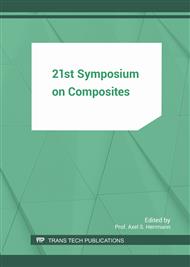[1]
G. W. Ehrenstein, Faserverbund-Kunststoffe: Werkstoffe, Verarbeitung, Eigenschaften, 2nd ed., Hanser, München, (2006).
DOI: 10.3139/9783446457546.fm
Google Scholar
[2]
A. S. Argon, R. E. Cohen, Toughenability of polymers, Polymer, 44 (2003) 6013-6032.
DOI: 10.1016/s0032-3861(03)00546-9
Google Scholar
[3]
B. Wetzel, P. Rosso, F. Haupert, K. Friedrich, Epoxy Nanocomposites, Eng. Fract. Mech., 73 (2006) 2375-2398.
DOI: 10.1016/j.engfracmech.2006.05.018
Google Scholar
[4]
A. F. Yee, R. A. Pearson, Toughening mechanisms in elastomer-modified epoxies, J. Mat. Sci., 21 (1986) 2462-2474.
DOI: 10.1007/bf01114293
Google Scholar
[5]
A. J. Kinloch, Mechanics and mechanisms of fracture of thermosetting epoxy polymers, in: Epoxy Resins and Composites I, Vol. 72, Advances in Polymer Science, Springer Berlin Heidelberg 1985, pp.45-67.
DOI: 10.1007/3-540-15546-5_2
Google Scholar
[6]
I. Srivastava, N. Koratkar, Fatigue and fracture toughness of epoxy nanocomposites, JOM, 62 (2010) 50-57.
DOI: 10.1007/s11837-010-0032-8
Google Scholar
[7]
Q. Zhang, L. A. Archer, Poly(ethylene oxide)/Silica Nanocomposites: Structure and Rheology, Langmuir, 18 (2002), 10435-10442.
DOI: 10.1021/la026338j
Google Scholar
[8]
J. N. Sultan, F. J. McGarry, Effect of rubber particle size on deformation mechanisms in glassy epoxy, Polym. Eng. Sci., 13 (1973) 29-34.
DOI: 10.1002/pen.760130105
Google Scholar
[9]
G. A. Crosbie, M. G. Phillips, Toughening of polyester resins by rubber modification, J. Mat. Sci., 20 (1985), 182-192.
DOI: 10.1007/bf00555911
Google Scholar
[10]
E. Martuscelli, P. Musto, G. Ragosta, G. Scarinzi, Reactive blending of thermosets: Molecular, morphological and mechanical analysis, Angew. Makromol. Chem., 217 (1994) 159-190.
DOI: 10.1002/apmc.1994.052170115
Google Scholar
[11]
B. S. Hayes, J. C. Seferis, Modification of thermosetting resins and composites through preformed polymer particles, Polym. Compos., 22 (2001) 451-467.
DOI: 10.1002/pc.10551
Google Scholar
[12]
R. A. Pearson, A. F. Yee, Influence of particle size and particle size distribution on toughening mechanisms in rubber-modified epoxies, J. Mat. Sci., 26 (1991) 3828-3844.
DOI: 10.1007/bf01184979
Google Scholar
[13]
Y. -J. Huang, J. -H. Wu, J. -G. Liang, M. -W. Hsu, J. -K. Ma, Toughening of unsaturated polyester resins with core–shell rubbers, J. Appl. Polym. Sci., 107 (2008) 939-950.
DOI: 10.1002/app.25159
Google Scholar
[14]
L. Becu-Longuet, A. Bonnet, C. Pichot, H. Sautereau, A. Maazouz, Influence of the particle structure and size on the rheological and mechanical properties, J. Appl. Polym. Sci., 72 (1999) 849-858.
DOI: 10.1002/(sici)1097-4628(19990509)72:6<849::aid-app10>3.0.co;2-r
Google Scholar
[15]
M. Ahmadi, M. R. Moghbeli, M. M. Shokrieh, Rubber modification of unsaturated polyester resin with core-shell rubber particles, Polym. Eng. Sci., 52 (2012) 1928-(1937).
DOI: 10.1002/pen.23154
Google Scholar
[16]
K. Xiao, L. Ye, Y. Kwok, Effects of pre-cracking methods on fracture behaviour of an Araldite-F epoxy and its rubber-modified systems, J. Mat. Sci., 33 (1998) 2831-2836.
Google Scholar
[17]
A. J. Kinloch, R. J. Young, Fracture Behaviour of Polymers, Springer, Dordrecht (1995).
Google Scholar
[18]
Low Temperature Impact Test, Association of Rotational Molders International, Vers. 4, (2003).
Google Scholar
[19]
W. W. Feng, K. L. Reifsnider, G. P. Sendeckyj, T. T. Chiao, W. S. Johnson, G. L. Rodericks, W. W. Stinchcomb, L. de Vore, D. L. Hunston, Composite Interlaminar Fracture, J. Compos. Technol. Res., 6 (1984) 176ff.
DOI: 10.1520/ctr10842j
Google Scholar
[20]
R. Bagheri, R. A. Pearson, Role of particle cavitation in rubber-toughened epoxies, Polymer, 37 (1996) 4529-4538.
DOI: 10.1016/0032-3861(96)00295-9
Google Scholar


